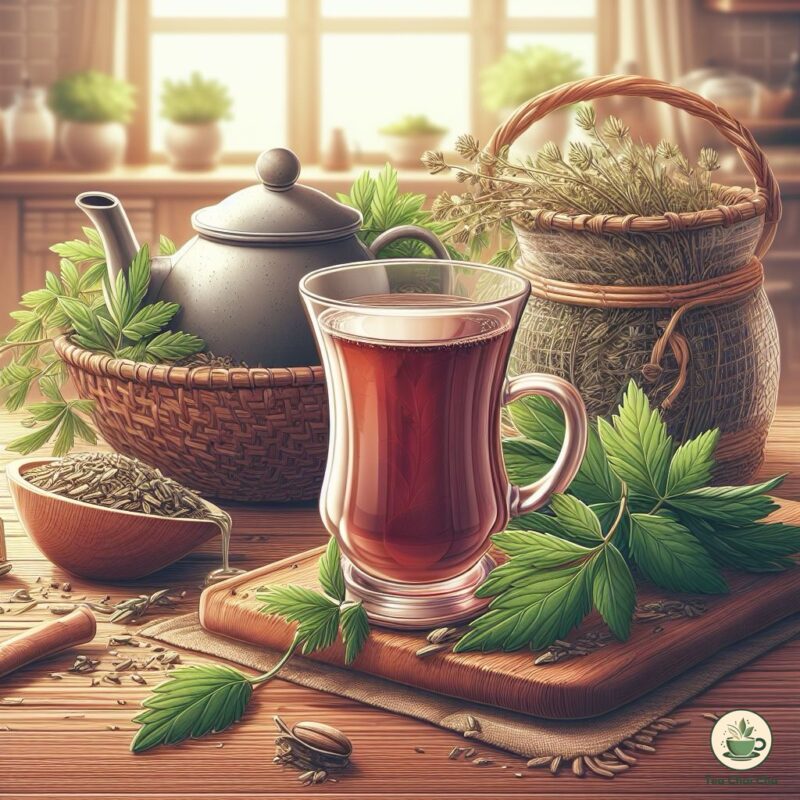What do you think about a soothing drink that’s not just delicious but might also have some potential health benefits?
Well, I’ve got something interesting to share with you – my experience with making mugwort tea.
Mugwort tea has been used since ancient times and people believe in their benefits to this day.
The best way to add mugwort in your routine is by making tea with this herb.
And that’s why I’m here, to share my quick recipe of mugwort tea with you!
Don’t worry if you’re not familiar with mugwort; I’ll guide you through the process step by step.
What Is Mugwort?
Mugwort is a plant that grows in Europe and Asia. It’s a pretty tall plant with strong roots.
The leaves underneath are silvery, which kind of reminds me of the moon.
Funny thing is, some people actually consider it a weed because it can take over spaces pretty easily.
But here’s the interesting part: mugwort has been used for a really long time in two cool ways – for health and for spiritual stuff.
Back in the old days, like the Middle Ages, people called it the “mother of herbs.” It was like a special plant.
People used it for making things like incense and bundles of dried leaves.
They would burn to help sick folks feel better and to keep away bad spirits.
And guess what?
Mugwort is connected to a goddess named Artemis from ancient Greece.
She’s all about nature, the moon, and women who could have babies.
So, mugwort was kind of like a helper for women’s cycles.
Even though there are hundreds of mugwort species, we’re talking about the regular one today.
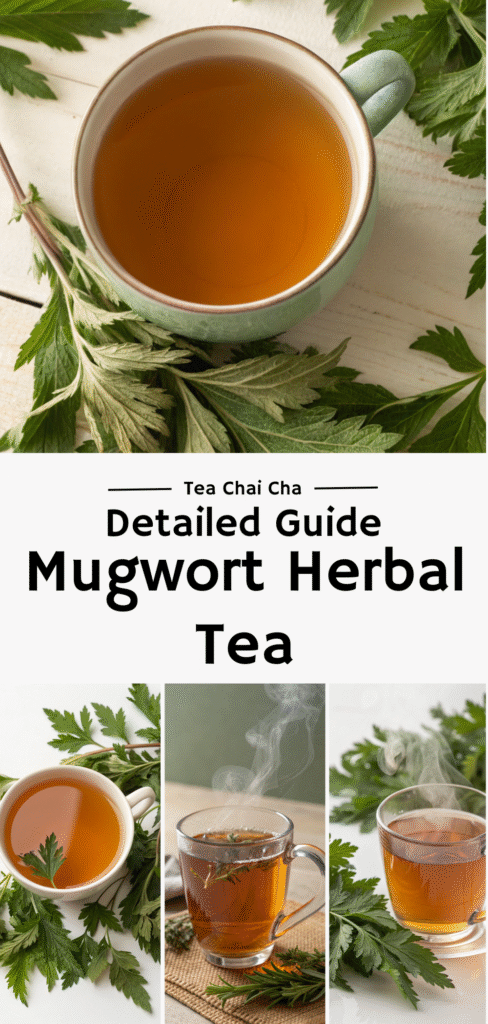
What Is Mugwort Tea?
Mugwort tea is a herbal drink made from the leaves and flowers of a plant called Artemisia vulgaris.
You can use the leaves and flowers when they’re fresh or after they’ve dried out.
People drink this tea not just because it might make them feel better, but also because it’s known for something really cool – helping with dreams!
Yep, you heard me right.
Mugwort is famous for being a “dreaming herb.”
When you drink the tea, some folks believe it can make your dreams more vivid and interesting.
It adds a little magic to your sleep and help you have more control over your dreams.
So, mugwort tea isn’t just a regular drink, it’s like a dream-time potion too. Pretty neat, right?
Mugwort Tea Benefits
This plant, known for its strong presence in the asteraceae family, has a wealth of medicinal benefits that have been cherished for centuries.
Using Mugwort for Digestion
Mugwort is a helper for your tummy.
It has something called “bitter principles (sesquiterpene lactones)” that make your digestive system work better.
It gets things moving in your stomach, pancreas, liver, and gallbladder.
This can help with problems like constipation and make it easier for your body to take in nutrients.
Plus, mugwort’s oils can make you feel hungry and help with issues like indigestion, bloating, and gas.
You might see mugwort in mixes with other herbs like elecampane, dandelion, and gentian that are good for your digestion.
Supporting Female Health
Mugwort does some cool things for women’s health too.
It can make your period start if it’s late and improve blood flow down there.
That means it can help with cramps and pain during your period.
So, it’s like a friend to have around during that time.
Related – How Much Mugwort Tea to Start Period Naturally
Relaxing and Helping with Sleep
When life gets too stressful and you can’t relax, mugwort might lend a hand.
It can help you feel less anxious and make it easier to fall asleep.
Other Useful Properties
Mugwort leaves have some extra powers too.
They can help your body get rid of extra water, fight germs.
It even deals with parasites and fungi.
Chinese Healing Tradition
In Chinese medicine, they do something called moxibustion with mugwort.
They burn dried mugwort close to the skin along with acupuncture to make it work even better and help energy flow in your body.
Mugwort Tea Side Effects
While mugwort tea can help your health in many ways, here are some things that you should be aware of.
1. Watch Your Dose
First off, it’s good to know that using too much mugwort or using it a lot isn’t a great idea.
See, there’s something called thujone in it, which is like an oil.
If you have too much of it, it can be bad for your brain.
So, it’s better to stick to blended teas that have less of this stuff.
2. Pregnancy and Nursing
Another thing to keep in mind is that mugwort can make your uterus more active.
That might sound weird, but it’s true.
So, if you’re pregnant, it’s better to avoid using mugwort.
Same goes if you’re nursing a baby.
3. Allergy Caution
Now, there’s this thing called sesquiterpene lactones in mugwort.
It’s a bit of a mouthful. But what matters is that it can cause allergies in some people.
Especially if you’re already allergic to other plants in the same family, like asteraceae.
So, if you’re one of those sensitive tea drinkers, be cautious.
Remember, what I’m saying here is just to help you understand.
If you want to use mugwort as medicine, it’s smart to talk to someone who knows about it – like a herbalist or a doctor.
And hey, don’t forget to tell your doctor and pharmacist if you’re using any herbal stuff, just to be safe.
Your health matters!
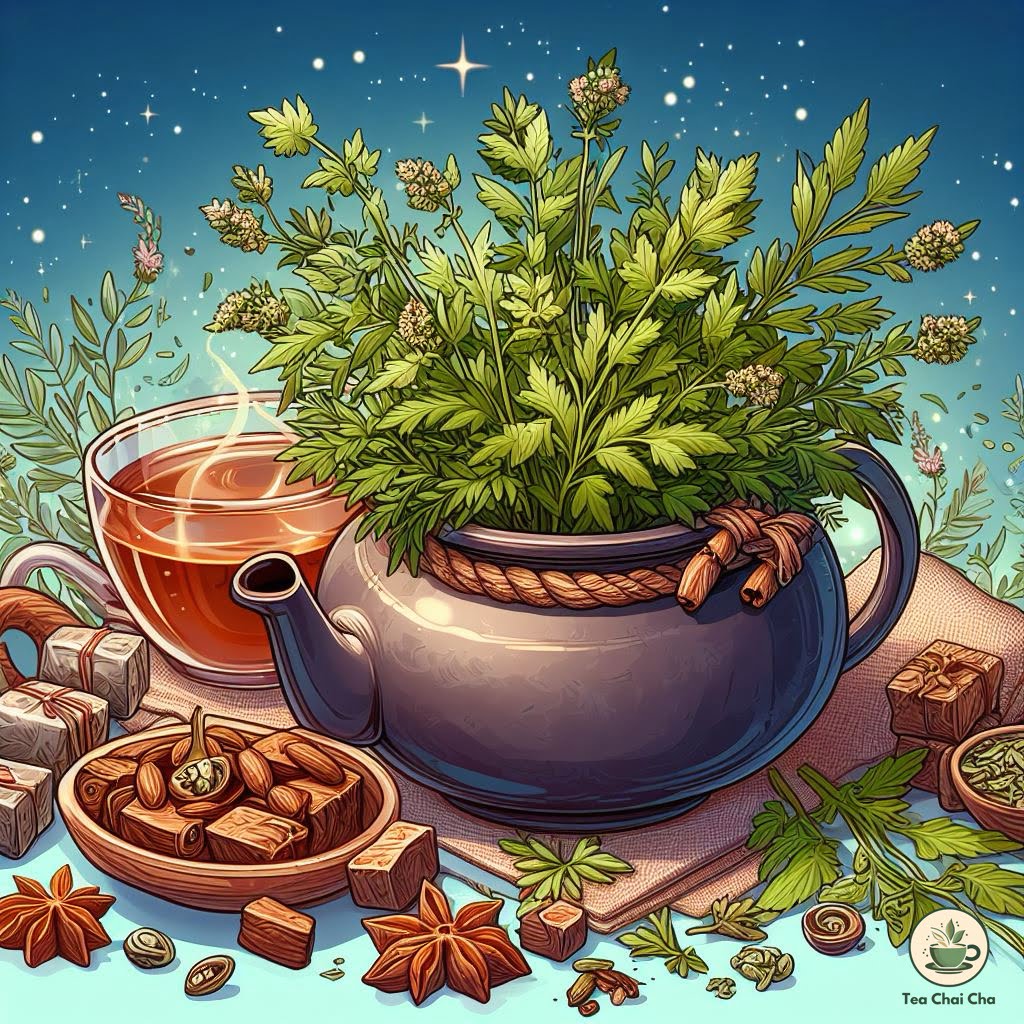
What You Need to Make Mugwort Tea
Getting ready to make mugwort tea? Awesome!
Here’s what you’ll need to make this special drink.
You’ve got a few options, so let me help you figure out what works best for you.
1. Fresh Mugwort Leaves and Flowers
If you’ve got access to a mugwort plant, you can use the fresh leaves and flowers.
Just pluck them off and give them a good rinse.
You’ll need about 1 to 2 teaspoons of the fresh stuff for each cup of tea.
2. Dried Mugwort Leaves and Flowers
If you can’t find fresh mugwort, don’t worry!
You can use dried leaves and flowers too.
You might find these at a health food store or online.
About 1 teaspoon of dried mugwort should be good for each cup of tea.
3. Tea Infuser or Strainer
No matter if you’re using fresh or dried mugwort, you’ll need something to keep the leaves and flowers from floating around in your tea.
4. Hot Water
This one’s a no-brainer.
You’ll need boiling water to brew your tea.
Just make sure it’s not boiling hot, but still steaming.
You can use a pot or electric kettle to heat your water.
5. Optional Sweeteners
Mugwort tea has a bit of a strong taste, so you might want to add a touch of sweetness.
Honey or a bit of sugar can do the trick.
But this part is totally up to you!

How to Prepare Mugwort for Tea
Let’s get your mugwort ready for that delicious tea.
This part is all about preparing the mugwort plant before you actually start making the tea.
1. Using Fresh Mugwort Leaves and Flowers
If you’re lucky enough to have fresh mugwort, great!
Here’s what you do: First, give those leaves and flowers a gentle rinse under cool water.
Then, let them dry on a clean towel.
Once they’re dry, you can use your fingers to break the leaves and flowers into smaller pieces. Easy peasy!
2. Using Dried Mugwort Leaves and Flowers
Using dried mugwort?
No worries, it’s just as good.
Take about 1 teaspoon of the dried stuff and put it in your tea infuser or strainer.
You don’t need to do much here since it’s already dried and ready to go.
3. Removing Tough Stems
Whether you’re using fresh or dried mugwort, it’s a good idea to remove any tough stems.
They might not taste that great in your tea.
Just pluck off the leaves and flowers, and if you see any woody stems, toss them aside.
4. Optional Grinding
If you want to get extra fancy, you can grind up the mugwort leaves and flowers a little bit.
This can release more of their flavor.
You can use a mortar and pestle if you have one, or even just your fingers to gently crush them.
Brewing Temperature and Steep Time for Mugwort Tea
Here’s a general guideline to make mugwort tea at home.
| Type of Mugwort Tea | Steeping Time | Water Temperature |
| Fresh Mugwort Leaves | 5 – 7 minutes | 190 – 200°F (87 – 93°C) |
| Dried Mugwort Leaves | 7 – 10 minutes | 200°F (93°C) |
| Mugwort Tea Bags | 5 – 7 minutes | 200°F (93°C) |
How to Make Mugwort Tea with Fresh Leaves
If you’ve got some fresh mugwort leaves and flowers on hand, you’re in for a treat.
This method gives you a more direct taste of the plant’s goodness.
Follow these steps to make your tea:
Step 1: Gather Your Goodies
First, pluck about 1 to 2 teaspoons of fresh mugwort leaves and flowers.
Prepare them as I mentioned above.
Step 2: Heat Some Water
The ideal water temperature for making mugwort tea is around 190 – 200°F (87 – 93°C).
It’s important not to use boiling water, as it can potentially degrade some of the delicate flavors and compounds in the mugwort.
So, let the water cool down for a minute or two after boiling before pouring it over the fresh mugwort leaves and flowers.
Step 3: Get Steeping
Place your fresh mugwort leaves and flowers into a cup or tea pot.
Pour the hot water over them.
Cover your cup with a saucer or a lid to trap the steam.
Let it steep for about 5 to 10 minutes.
This lets the mugwort goodness infuse into the water.
Step 4: Strain and Sip
After steeping, use a tea infuser or strainer to catch the leaves and flowers as you pour the tea into another cup (if you are steeping in a cup.)
Now, take a sip and see how you like it!
If you find it a bit strong, you can add a touch of honey or sugar to sweeten it up.
Step 5: Enjoy and Dream
Find a cozy spot, sit back, and enjoy your mugwort tea.
Some people like to drink it before bed to see if it adds a dash of magic to their dreams.
Remember, everyone’s different, so have fun experimenting!
Scroll to the bottom to have complete recipe with ingredients and instructions.
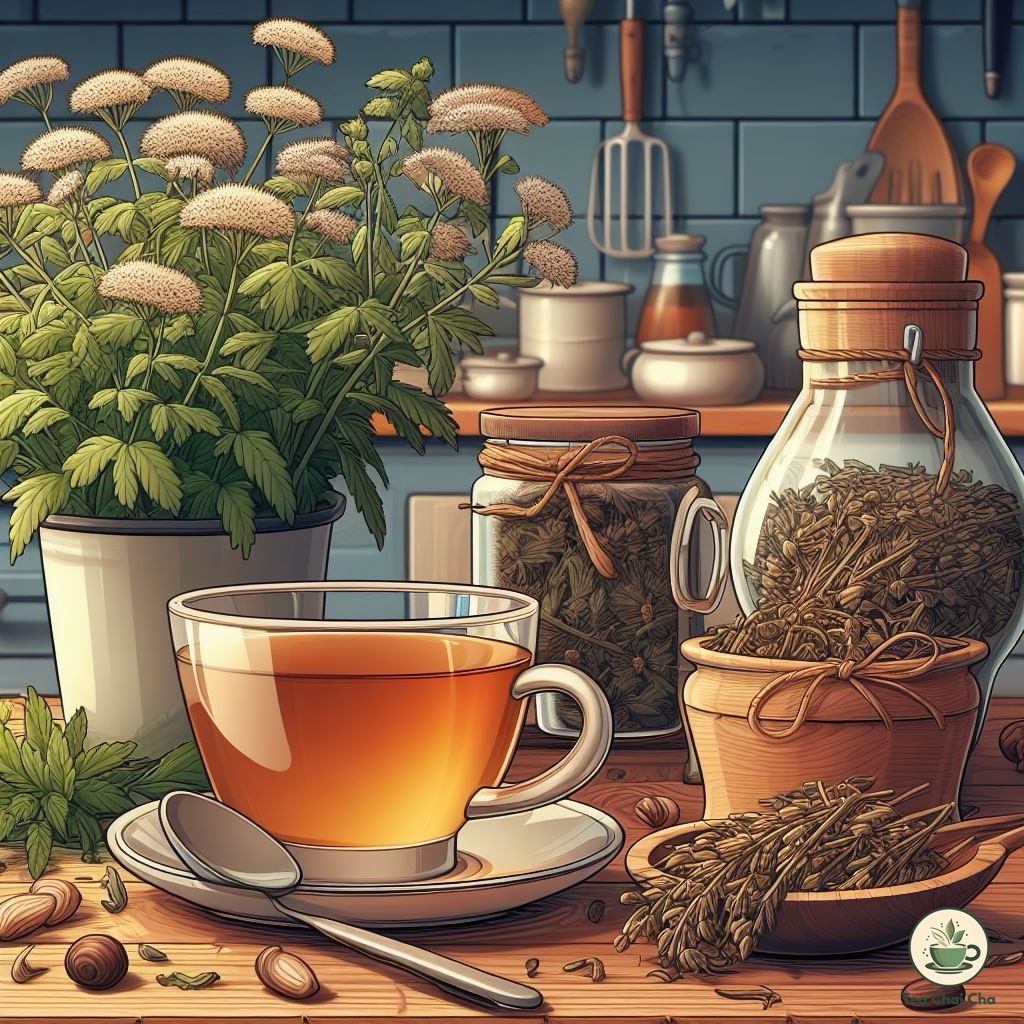
How to Make Tea with Dried Mugwort
Using dried mugwort is just as effective as using fresh leaves and flowers.
Follow these steps to create your mugwort tea:
Step 1: Gather Your Supplies
First things first, make sure you have everything you need: dried mugwort leaves, a tea infuser or strainer, a cup, and some hot water.
You’re almost ready to start!
Step 2: Measure the Mugwort
For one cup of tea, you’ll want about 1 teaspoon of dried mugwort.
If you’re making more than one cup, adjust the amount accordingly.
Step 3: Prepare Your Infuser or Strainer
Put the dried mugwort into your tea infuser or strainer.
This will keep the leaves from floating around in your tea.
Step 4: Boil Some Water
Heat your water until it’s steaming but not boiling vigorously.
About 190 – 200°F (87 – 93°C) should do the trick.
Step 5: Infuse the Mugwort
Place your infuser or strainer into your cup, and carefully pour the hot water over the dried mugwort.
Now, let it steep.
You’ll want to steep it for about 5 to 10 minutes.
This time lets the mugwort release its flavors and goodness into the water.
Step 6: Sweeten (Optional)
Once your tea has steeped, you can add a bit of honey or sugar if you like to sweeten it up a tad.
This part is totally up to your taste buds.
Step 7: Sip and Enjoy
Your mugwort tea is ready!
Take a sip and see how you like it.
Remember, mugwort tea has a unique taste, so it might be different from what you’re used to.
How to Dry Mugwort for Tea
If you happen to have fresh mugwort leaves and you want to save them for future tea-making, drying them is a fantastic idea.
Here’s how you can do it:
Step 1: Gather Your Fresh Leaves
Start by collecting the fresh mugwort leaves you’d like to dry.
Choose leaves that are healthy and free from any signs of damage.
Step 2: Wash and Dry
Give the leaves a gentle wash to remove any dirt or bugs.
Pat them dry with a clean towel.
Step 3: Bundle and Tie
Take the top 8 inches of the mugwort plant’s stems and leaves.
These are the most aromatic and potent parts.
Lay them out on a clean surface.
When they’re almost completely dry but still a bit flexible, it’s the perfect time to bundle them up.
Step 4: Create Bundles
Make bundles of the dried leaves and stems, about 1 inch thick, with the stem ends together.
This will help the leaves dry uniformly.
Step 5: Secure with Thread
Starting at the stem end, wind cotton thread in a spiral around the bundle.
Move towards the tip of the bundle and then back down to the stem end again.
This helps keep the bundle together as it continues to dry.
Step 6: Let Them Dry Completely
Once you’ve wound the thread around the bundle, tie it securely at the stem end.
Hang the bundles in a cool, dark, and well-ventilated space to let them dry completely.
This process can take about a week.
The bundles should feel brittle and crumbly to the touch when they’re fully dried.
Step 7: Store the Dried Bundles
When the bundles are completely dry, carefully remove the thread and store the dried mugwort bundles in an airtight container.
Keep the container in a cool, dark place to maintain the flavor and potency of the dried leaves.
Step 8: Make Tea Whenever You Want
Whenever you’re in the mood for some mugwort tea, just follow the steps mentioned earlier for making tea using dried leaves.
Your homemade dried mugwort bundles are all set to bring their magical qualities to your cup.
Tip – Using an Oven (Quick Drying)!
If you’re in a hurry, you can use your oven to dry the leaves.
Place the leaves on a baking sheet and set the oven to the lowest temperature possible (around 100°F or 40°C).
Keep the oven door slightly ajar to allow moisture to escape.
Once dried, store them properly.
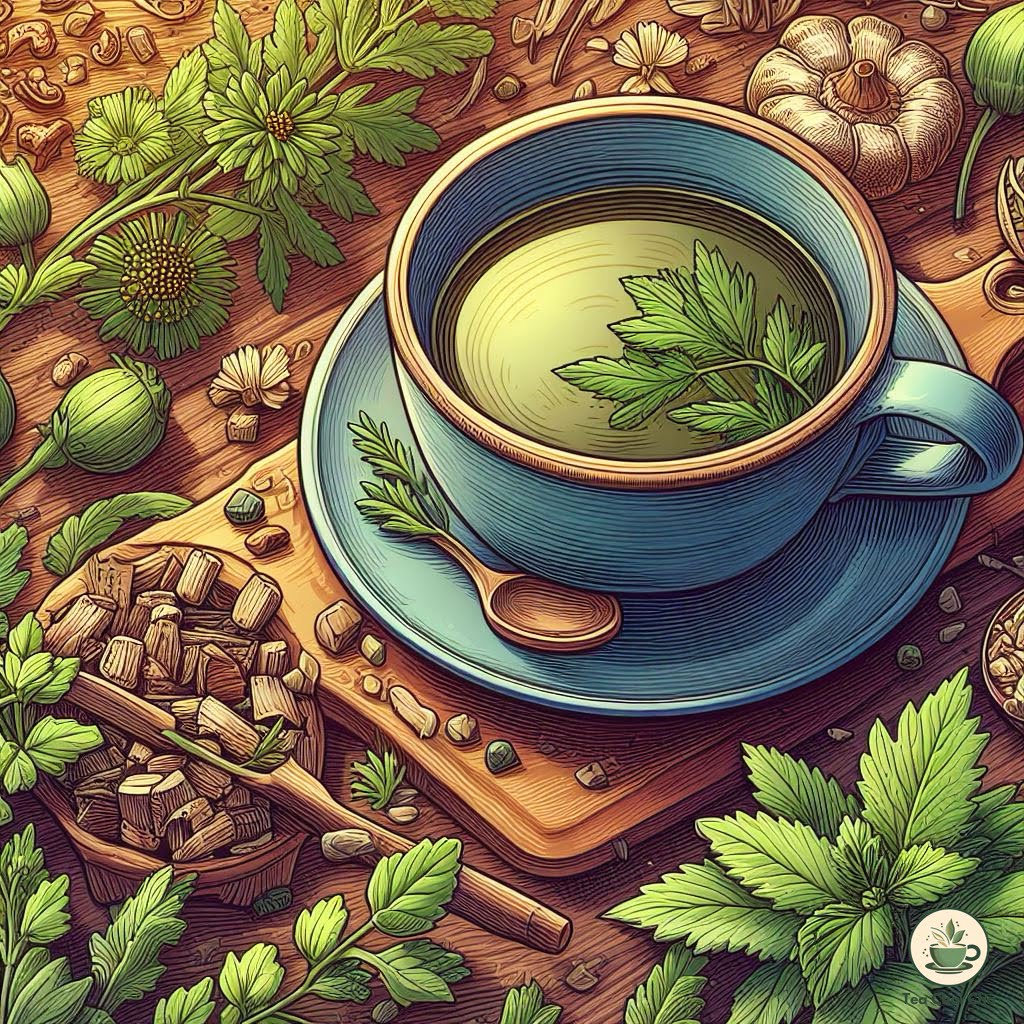
Mugwort Tea Hot or Cold?
When it comes to mugwort tea, you’ve got a choice to make: enjoy it hot or give it a chill and have it cold.
Both ways have their own flavors and perks, so let me break it down for you.
Hot Mugwort Tea
When you steep mugwort in hot water, it releases a warm, earthy flavor.
It’s a bit strong and can be a tad bitter, which is why some folks like to add a touch of sweetness with honey or sugar.
Plus, a cup of warm mugwort tea before bedtime can create a soothing bedtime routine, especially if you’re curious about its potential dream-enhancing effects.
I usually go for hot mugwort tea when I want to wind down and relax.
Cold Mugwort Tea
On the flip side, cold mugwort tea can be super refreshing, especially on a hot day.
It’s like a herbal iced tea adventure!
You might notice slightly different flavors when it’s cold.
Some people enjoy cold mugwort tea for its earthy taste and potential cooling effects.
Flavor and Benefits
The temperature of your mugwort tea can slightly affect its flavor.
Generally, hot mugwort tea might have a more pronounced taste, while cold mugwort tea can be milder.
As for the benefits, whether you enjoy it hot or cold, you should still be able to experience the potential soothing effects of mugwort.
Just keep in mind that individual experiences can vary.
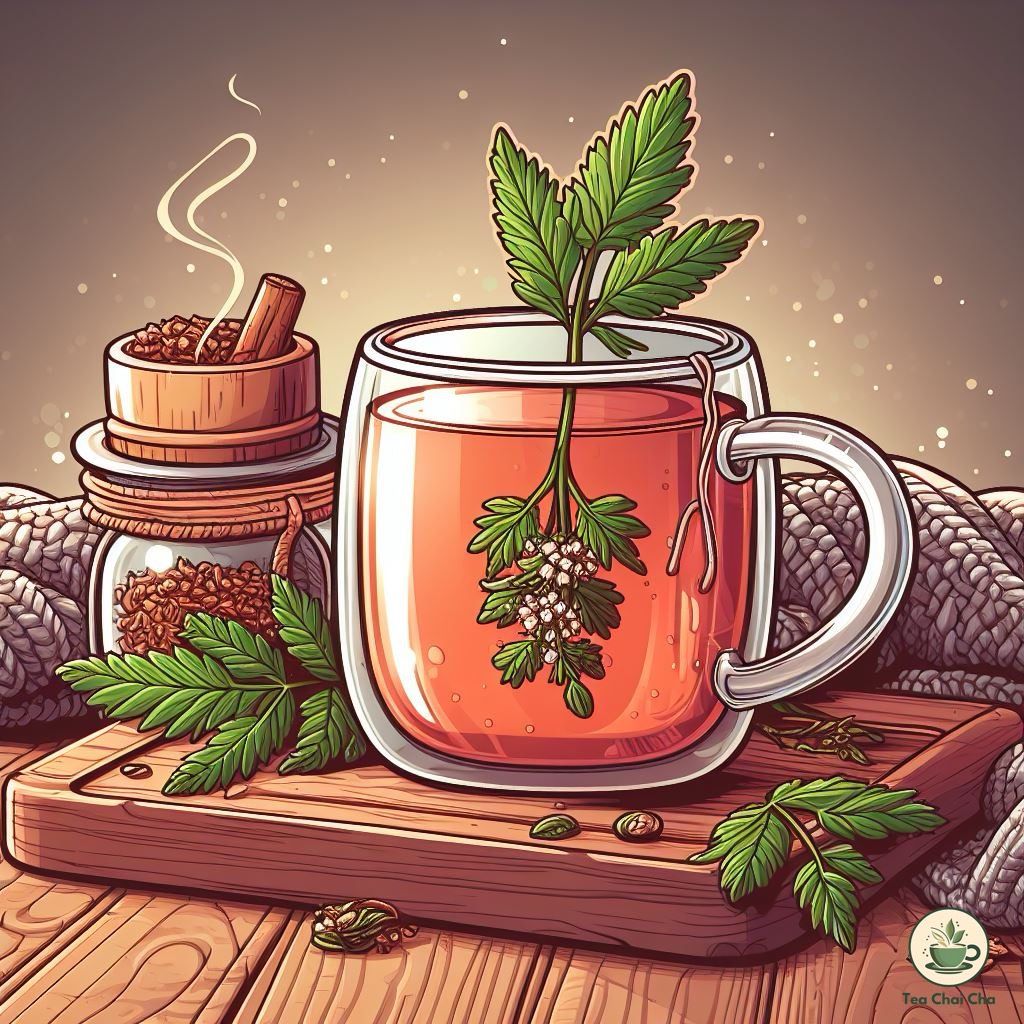
How to Make Mugwort Iced Tea
When the weather gets warm, turning your mugwort tea into a chilled delight is a fantastic idea.
You’ve got two ways to do it: the regular iced method and the cold brew method.
Ingredients
- 1 tablespoon of dried mugwort leaves and flowers (or 2 tablespoons if you prefer a stronger flavor)
- 2 cups of hot water
- Ice cubes
- Optional: Sweetener of your choice (e.g., honey, sugar, or a sugar substitute)
- Lemon slices or mint leaves for garnish (optional)
Method 1: Traditional Iced Tea
Step 1: Prepare Your Mugwort
Start by measuring out your dried mugwort leaves and flowers.
Use 1 tablespoon per 2 cups of water if you want a milder flavor or 2 tablespoons for a stronger brew.
Step 2: Steep
Boil 2 cups of water and then let it cool down for a minute or two.
Pour the hot water over your measured mugwort in a heat-safe container.
Cover it and let it steep for about 5 minutes.
This will allow the flavors to infuse into the water.
Step 3: Strain and Chill
After steeping, strain out the mugwort leaves and flowers.
You can use a fine-mesh strainer or a coffee filter for this.
Let the tea cool down to room temperature, and then refrigerate it until it’s nice and cold, usually for about 1 to 2 hours.
Step 4: Serve
Pour your chilled mugwort tea over ice cubes in a glass.
If you prefer a touch of sweetness, add your sweetener of choice to taste.
Garnish with a slice of lemon or a sprig of mint for an extra refreshing touch.
Method 2: Cold Brew Iced Tea
Step 1: Easy Soaking
Cold brew mugwort tea is a breeze to make.
In a pitcher, mix 1 tablespoon of dried mugwort leaves and flowers with 2 cups of cold water.
Give it a good stir to ensure the mugwort is evenly soaked.
Step 2: Chill and Steep
Once mixed, cover the pitcher and let it relax in the fridge.
Allow the tea to steep slowly over 4 to 6 hours, or even leave it overnight for a more robust flavor.
Step 3: Gentle Straining
When your cold brew time is up, it’s time to remove the leaves and flowers.
Use a fine-mesh strainer or a coffee filter to strain the tea into another container.
This will leave you with a smooth and refreshing infusion.
Step 4: Serve and Enjoy
Now comes the rewarding part.
Fill your glass with ice cubes, pour in the chilled mugwort tea, and if you like it sweet, add your preferred sweetener.
For a touch of sophistication, drop in a slice of lemon or a sprig of mint.
Sip back, relax, and relish the delightful herbal coolness.
For both methods, you can adjust the amount of dried mugwort and steeping time according to your taste preferences.
Remember, mugwort has a strong flavor, so you might want to start with a shorter steeping time if you’re new to it.
Also, if you’re pregnant or have certain medical conditions, consult a healthcare professional before enjoying mugwort tea.
7 Factors That Affect the Flavor of Mugwort Tea
Having enjoyed mugwort tea myself, I’d like to share some insights to help you make the best choice based on your preferences.
Here are some factors that affect the flavor of mugwort tea:
1. Mugwort Variety
Just like with any tea, the type of mugwort you choose plays a crucial role in the flavor.
There are several species of mugwort, and each can offer a slightly different taste profile.
Common mugwort (Artemisia vulgaris) and Japanese mugwort (Artemisia princeps) are popular options.
Common mugwort tends to have a more robust, earthy flavor, while Japanese mugwort often has a sweeter, milder taste.
2. Harvest Time
The time of year when the mugwort is harvested can significantly impact its flavor.
Young leaves and shoots harvested in the spring tend to be more tender and have a lighter, slightly sweet flavor.
In contrast, leaves harvested later in the growing season may be more bitter and robust.
Consider your preference for sweetness or bitterness when choosing your mugwort.
3. Drying and Processing
The way mugwort is dried and processed can affect its flavor.
Air-dried mugwort tends to retain more of its natural aroma and flavor compared to oven-dried varieties.
You may find that traditionally dried mugwort offers a more authentic and nuanced taste.
4. Storage Conditions
Proper storage is vital to maintaining the flavor of mugwort tea.
Keep your mugwort in an airtight container away from direct sunlight and moisture to preserve its freshness.
Stale or improperly stored mugwort can lose its aromatic qualities and develop a bland taste.
5. Brewing Time and Temperature
The way you brew your mugwort tea can also impact its flavor.
Experiment with brewing times and water temperatures to find the balance that suits your taste.
Generally, a shorter steeping time and lower temperature will result in a milder flavor.
Besides, a longer steeping time and higher temperature can yield a stronger, more robust taste.
6. Combining Ingredients
Mugwort tea can be enjoyed on its own or combined with other herbs and spices to create unique flavor profiles.
For example, adding a touch of honey or lemon can enhance the sweetness and brightness of the tea.
Besides, spices like cinnamon or ginger can introduce a warm and spicy dimension.
7. Blending with Other Herbs
Sometimes, it’s fun to get creative and blend mugwort with other herbs.
Whether it’s a touch of mint for freshness or a hint of chamomile for a soothing undertone, the possibilities are endless.
These herbal combinations can complement and transform the flavor of your mugwort tea into something uniquely yours.
Mugwort and Food Interactions
Mugwort contains thujone, a compound that can have varying effects on individuals.
Thujone is also found in other plants like wormwood, which is used to make absinthe.
Moderate consumption of mugwort tea is generally considered safe.
But it’s wise to avoid pairing it with certain foods or supplements that may have similar effects or compounds.
Foods like certain cheeses, certain alcoholic beverages (like absinthe), and foods high in thujone should be avoided when drinking mugwort tea.
Foods to Avoid Pairing with Mugwort Tea
1. Absinthe or High-Thujone Alcoholic Beverages
Avoid consuming absinthe or other high-thujone alcoholic drinks alongside mugwort tea, as they can contribute to thujone accumulation.
2. Foods High in Thujone
Certain herbs like sage, tarragon, and oregano also contain thujone.
It’s advisable to avoid consuming these herbs in large amounts alongside mugwort tea.

When to Drink Mugwort Tea
Drinking mugwort tea before bedtime can create a calming effect on the mind and body.
The compounds in mugwort are believed to interact with certain receptors in the brain, promoting relaxation and reducing stress.
This can be particularly helpful if you often find yourself tossing and turning, unable to quiet your thoughts when it’s time to sleep.
My Experience!
I remember the first time I tried mugwort tea before bedtime.
I had been struggling with occasional sleeplessness and was looking for a natural solution.
So, I brewed a cup of mugwort tea, let it steep for a few minutes, and sipped it slowly.
I was pleasantly surprised by how its gentle warmth seemed to envelop me, easing away the tension of the day.
Besides, I found that drinking mugwort tea about 30 minutes to an hour before I planned to sleep worked best for me.
It gave me time to unwind, read a book, or simply relax without the rush of the day’s activities.
The gradual onset of its calming effects made the transition from wakefulness to sleepiness feel natural.
Related to Tea Making
Fresh Mugwort Tea Recipe
Recipe by Tania FaysalCourse: DrinksCuisine: Other world cuisine1
servings5
minutes5
minutes5
kcal10
minutesMake mugwort tea using this simple recipe and enjoy its benefits!
Ingredients
1-2 teaspoons of fresh mugwort leaves (or 1 teaspoon if dried)
1 cup of hot water
1-2 teaspoons of honey or a sweetener of your choice
A dash of lemon juice (optional, to taste)
Directions
- Place your mugwort leaves into a teapot or a mug.
- Pour hot (not boiling) water over the leaves.
- Allow the tea to steep for about 5-7 minutes.
- Strain the tea into a cup.
- Add honey or your preferred sweetener.
- Squeeze a dash of lemon for a tangy twist!
Recipe Video
Notes
- Fresh leaves. Ensure your mugwort leaves are clean and fresh. If you’re using fresh leaves, wash them under running water and pat dry. The sweetener, hot water, and lemon are standby for action!
- Look for vibrant green leaves. The healthier the leaf, the better the brew.
- Opt for organically grown mugwort. The last thing you want in your soothing cup of tea is a dash of pesticides!
- Be aware of the smell. Fresh mugwort has a strong, distinctive aroma that’s hard to miss.
Frequently Asked Questions (FAQs)
What does mugwort tea taste like?
Mugwort tea has a unique flavor profile that’s often described as earthy and slightly bitter. It might remind you of a cross between sage and chamomile.
The taste can vary based on factors like the type of mugwort used and how it’s prepared, but overall, it tends to have a soothing and herbal taste.
Does mugwort tea have caffeine?
No, mugwort tea is naturally caffeine-free.
This makes it a great option for those looking for a calming beverage to enjoy in the evening without worrying about caffeine-induced sleep disturbances.
Is mugwort a real tea?
Technically, mugwort tea is not made from the traditional tea plant (Camellia sinensis), so it’s not considered a “true” tea.
Instead, it’s an herbal infusion made from the leaves and flowers of the mugwort plant.
How many calories are in mugwort tea?
Mugwort tea is very low in calories, typically containing around 0-5 calories per cup.
How to make mugwort tea less bitter?
If you find mugwort tea too bitter for your taste, you can try a few strategies to mellow out the bitterness.
One way is to blend it with other herbs like peppermint or chamomile, which can add a touch of sweetness and balance.
You can also add a teaspoon of honey or a slice of lemon to enhance the flavor and cut down on the bitterness.
How to make mugwort tea without a strainer?
If you don’t have a strainer, no worries! You can make mugwort tea using the “pour-over” method.
Simply place the mugwort leaves or tea bag in a cup, pour hot water over them, and let them steep for a few minutes.
Once the steeping time is up, carefully sip the tea, leaving the leaves or tea bag at the bottom of the cup.
What are mugwort tea effects?
Mugwort tea is believed to have several potential effects, including promoting relaxation, aiding digestion, and even helping with sleep.
It contains compounds that interact with receptors in the brain, possibly leading to feelings of calmness.
However, effects can vary from person to person, so it’s important to observe how your body responds.
What to mix with mugwort tea?
Mugwort tea can be blended with various other herbs and flavors to create a delightful drink.
Some popular options include chamomile, lavender, peppermint, or lemon balm.
These herbs can complement the earthy flavor of mugwort and add interesting layers of taste and aroma.

